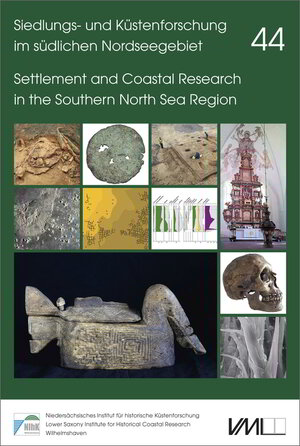Aktuelle Forschungen zur Landnutzungs- und Kulturgeschichte des Nordseeküstenraums
Current research on the land use and cultural history of the North Sea coastal region
Die acht Aufsätze des vorliegenden Bandes berichten über aktuelle Forschungen zur Landnutzungs- und Kulturgeschichte des Nordseeküstenraums. Der erste Beitrag ist der systematischen Suche nach gut erhaltenen mesolithischen Siedlungsspuren und der Entdeckung von Birkenrindenmatten im westlichen Ostfriesland gewidmet, die auf einen im Moor gut konservierten spätmesolithischen Lagerplatz schließen lassen. Es folgt eine archäologischmetallurgische Studie, die Klarheit über Entstehung und historische Kontextualisierung der berühmten Helgoländer Kupfer-Reißscheiben schafft. Den chronologischen Schwerpunkt des Bandes stellt ohne Zweifel die Römische Kaiserzeit dar. In den fünf Aufsätze geht es sowohl um neue Erkenntnisse über in Ostfriesland identifizierte Celtic fields und siedlungsarchäologische Forschungen im Landkreis Cuxhaven als auch um neue interdisziplinäre Untersuchungen an den überregional bekannten Gräberfeldern Fallward und Apensen. Dabei stehen einerseits die Diskussion methodischer Fragen der unter Laborbedingungen urchzuführenden Erforschung organischer Objekte und andererseits die dabei neu gewonnenen, kulturgeschichtlich spannenden Erkenntnisse im Mittelpunkt. Den Abschluss bildet eine Studie über ein bei einer Kirchensanierung in Varel entdecktes, aus Italien stammendes Majolikagefäß, das im Verlauf des 14. Jahrhunderts in den Norden gelangte und so schlaglichtartig Verbindungen zwischen dem Mittelmeerraum und dem Nordseeraum während des späten Mittelalters aufzeigt.
The eight contributions to this volume report on current research on land use and cultural history in the North Sea region. The first chapter is dedicated to the systematic search for well-preserved Mesolithic settlement traces and the discovery of birch bark mats in western East Frisia. The find suggests the existence of a well-preserved Late Mesolithic camp in a boggy location. This is followed by an archaeological and metallurgical study which clarifies the origin and historical context of the famous Heligoland copper Reißscheiben ingots. Undoubtedly, however, it is the Roman period that forms the chronological focus of this volume. The five corresponding chapters discuss new insights on Celtic fields identified in East Frisia, as well as settlement archaeology in the Cuxhaven district and new interdisciplinary work at the cemeteries of Fallward and Apensen, well-known across a wider region. Attention centres on the discussion of methodological questions regarding the investigation of organic artefacts in the laboratory, but also on the new and exciting culture-historical insights this yields. The volume ends with a contribution on an Italian majolica vessel, discovered during the renovation of a church in Varel. The item reached northern Europe in the course of the 14th century and thereby highlights connections between the Mediterranean and North Sea areas in the Late Middle Ages.
The eight contributions to this volume report on current research on land use and cultural history in the North Sea region. The first chapter is dedicated to the systematic search for well-preserved Mesolithic settlement traces and the discovery of birch bark mats in western East Frisia. The find suggests the existence of a well-preserved Late Mesolithic camp in a boggy location. This is followed by an archaeological and metallurgical study which clarifies the origin and historical context of the famous Heligoland copper Reißscheiben ingots. Undoubtedly, however, it is the Roman period that forms the chronological focus of this volume. The five corresponding chapters discuss new insights on Celtic fields identified in East Frisia, as well as settlement archaeology in the Cuxhaven district and new interdisciplinary work at the cemeteries of Fallward and Apensen, well-known across a wider region. Attention centres on the discussion of methodological questions regarding the investigation of organic artefacts in the laboratory, but also on the new and exciting culture-historical insights this yields. The volume ends with a contribution on an Italian majolica vessel, discovered during the renovation of a church in Varel. The item reached northern Europe in the course of the 14th century and thereby highlights connections between the Mediterranean and North Sea areas in the Late Middle Ages.






